| dc.contributor.author | Hodges, Samuel | |
| dc.contributor.author | Erikstad, Kjell E. | |
| dc.contributor.author | Reiertsen, Tone Kristin | |
| dc.coverage.spatial | Barents Sea | en_US |
| dc.date.accessioned | 2023-02-27T14:01:26Z | |
| dc.date.available | 2023-02-27T14:01:26Z | |
| dc.date.created | 2023-02-13T09:16:48Z | |
| dc.date.issued | 2022 | |
| dc.identifier.citation | Ecological Solutions and Evidence. 2022, 3 (4), . | en_US |
| dc.identifier.issn | 2688-8319 | |
| dc.identifier.uri | https://hdl.handle.net/11250/3054345 | |
| dc.description.abstract | 1. The conservation of seabirds is increasingly important for their role as indicator species of ocean ecosystems, which are predicted to experience increasing levels of exploitation this century. Safeguarding these ecosystems will require predictive, spatial studies of seabird foraging hotspots. Current research on seabird foraging hotspots has established a significant relationship between probability of presence and several environmental variables, including Sea Surface Temperature (SST). However, inter-annual, basin-wide variation has the potential to invalidate these models, which depend on seasonal mesoscale variability. 2. In this study, we present a novel solution to predict presence from spatially and temporally variable environmental predictors, while reducing the influence of large-scale basin-wide variation. We model the Maximum Entropy (MaxENT) Model-derived relationship between Standardized Monthly SST (StdSST) and Habitat Suitability using Gaussian curve models, and then apply these models to independent StdSST data to produce heatmaps of predicted seabird presence. 3. In this study, we demonstrate StdSST to be a functional environmental predictor of seabird presence, within a Gaussian curve model framework. We demonstrate accurate predictions of the model’s training data and of independent seabird presence data to a high degree of accuracy (area under the receiver operator characteristic curve > 0.65) for four species of Auk: Common Guillemots (Uria aalge), Razorbills (Alca torda), Atlantic Puffins (Fratercula arctica) and Brunnich’s Guillemots (Uria lomvia). 4. We believe that the methodology we have developed and tested in this study can be used to guide ecosystem management practices by converting coupled-climate model predictions into predictions of future presence based on Habitat Suitability for the species, allowing us to consider the possible effects of climate change and yearly variation of SST on foraging seabird hotspots in the Barents Sea Atlantic Puffin, Barents Sea, Brunnich’s Guillemot, Common Guillemot, ecological modelling, MaxENT, Razorbill, spatial ecology | en_US |
| dc.language.iso | eng | en_US |
| dc.rights | Navngivelse 4.0 Internasjonal | * |
| dc.rights.uri | http://creativecommons.org/licenses/by/4.0/deed.no | * |
| dc.subject | Atlantic Puffin | en_US |
| dc.subject | Barents Sea | en_US |
| dc.subject | Brunnich’s Guillemot | en_US |
| dc.subject | Common Guillemot | en_US |
| dc.subject | ecological modelling | en_US |
| dc.subject | MaxENT | en_US |
| dc.subject | Razorbill | en_US |
| dc.subject | spatial ecology | en_US |
| dc.title | Predicting the foraging patterns of wintering Auks using a sea surface temperature model for the Barents Sea | en_US |
| dc.title.alternative | Predicting the foraging patterns of wintering Auks using a sea surface temperature model for the Barents Sea | en_US |
| dc.type | Peer reviewed | en_US |
| dc.type | Journal article | en_US |
| dc.description.version | publishedVersion | en_US |
| dc.rights.holder | © 2022 The Authors | en_US |
| dc.subject.nsi | VDP::Zoologiske og botaniske fag: 480 | en_US |
| dc.subject.nsi | VDP::Zoology and botany: 480 | en_US |
| dc.source.pagenumber | 0 | en_US |
| dc.source.volume | 3 | en_US |
| dc.source.journal | Ecological Solutions and Evidence | en_US |
| dc.source.issue | 4 | en_US |
| dc.identifier.doi | 10.1002/2688-8319.12181 | |
| dc.identifier.cristin | 2125402 | |
| dc.relation.project | Andre: Office of Naval Research | en_US |
| dc.relation.project | Andre: National Ocean Partnership Program | en_US |
| dc.relation.project | Andre: U.S. Navy | en_US |
| dc.relation.project | Egen institusjon: Norwegian institute for nature research (NINA) | en_US |
| dc.source.articlenumber | e12181 | en_US |
| cristin.ispublished | true | |
| cristin.fulltext | original | |
| cristin.qualitycode | 1 | |

